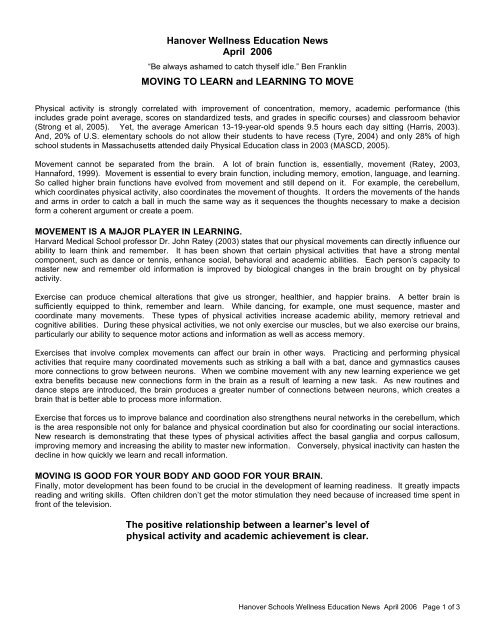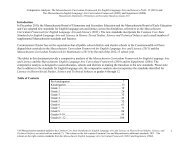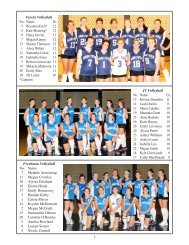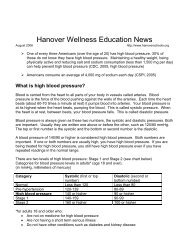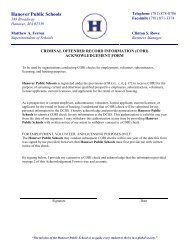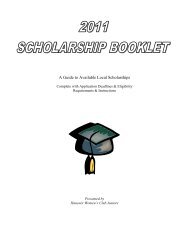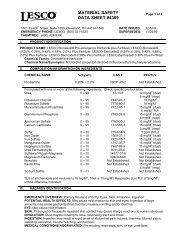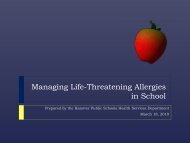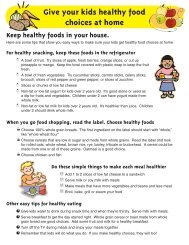Moving to learn and learning to move. The importance of physical ...
Moving to learn and learning to move. The importance of physical ...
Moving to learn and learning to move. The importance of physical ...
Create successful ePaper yourself
Turn your PDF publications into a flip-book with our unique Google optimized e-Paper software.
Hanover Wellness Education News<br />
April 2006<br />
“Be always ashamed <strong>to</strong> catch thyself idle.” Ben Franklin<br />
MOVING TO LEARN <strong>and</strong> LEARNING TO MOVE<br />
Physical activity is strongly correlated with improvement <strong>of</strong> concentration, memory, academic performance (this<br />
includes grade point average, scores on st<strong>and</strong>ardized tests, <strong>and</strong> grades in specific courses) <strong>and</strong> classroom behavior<br />
(Strong et al, 2005). Yet, the average American 13-19-year-old spends 9.5 hours each day sitting (Harris, 2003).<br />
And, 20% <strong>of</strong> U.S. elementary schools do not allow their students <strong>to</strong> have recess (Tyre, 2004) <strong>and</strong> only 28% <strong>of</strong> high<br />
school students in Massachusetts attended daily Physical Education class in 2003 (MASCD, 2005).<br />
Movement cannot be separated from the brain. A lot <strong>of</strong> brain function is, essentially, <strong>move</strong>ment (Ratey, 2003,<br />
Hannaford, 1999). Movement is essential <strong>to</strong> every brain function, including memory, emotion, language, <strong>and</strong> <strong>learn</strong>ing.<br />
So called higher brain functions have evolved from <strong>move</strong>ment <strong>and</strong> still depend on it. For example, the cerebellum,<br />
which coordinates <strong>physical</strong> activity, also coordinates the <strong>move</strong>ment <strong>of</strong> thoughts. It orders the <strong>move</strong>ments <strong>of</strong> the h<strong>and</strong>s<br />
<strong>and</strong> arms in order <strong>to</strong> catch a ball in much the same way as it sequences the thoughts necessary <strong>to</strong> make a decision<br />
form a coherent argument or create a poem.<br />
MOVEMENT IS A MAJOR PLAYER IN LEARNING.<br />
Harvard Medical School pr<strong>of</strong>essor Dr. John Ratey (2003) states that our <strong>physical</strong> <strong>move</strong>ments can directly influence our<br />
ability <strong>to</strong> <strong>learn</strong> think <strong>and</strong> remember. It has been shown that certain <strong>physical</strong> activities that have a strong mental<br />
component, such as dance or tennis, enhance social, behavioral <strong>and</strong> academic abilities. Each person’s capacity <strong>to</strong><br />
master new <strong>and</strong> remember old information is improved by biological changes in the brain brought on by <strong>physical</strong><br />
activity.<br />
Exercise can produce chemical alterations that give us stronger, healthier, <strong>and</strong> happier brains. A better brain is<br />
sufficiently equipped <strong>to</strong> think, remember <strong>and</strong> <strong>learn</strong>. While dancing, for example, one must sequence, master <strong>and</strong><br />
coordinate many <strong>move</strong>ments. <strong>The</strong>se types <strong>of</strong> <strong>physical</strong> activities increase academic ability, memory retrieval <strong>and</strong><br />
cognitive abilities. During these <strong>physical</strong> activities, we not only exercise our muscles, but we also exercise our brains,<br />
particularly our ability <strong>to</strong> sequence mo<strong>to</strong>r actions <strong>and</strong> information as well as access memory.<br />
Exercises that involve complex <strong>move</strong>ments can affect our brain in other ways. Practicing <strong>and</strong> performing <strong>physical</strong><br />
activities that require many coordinated <strong>move</strong>ments such as striking a ball with a bat, dance <strong>and</strong> gymnastics causes<br />
more connections <strong>to</strong> grow between neurons. When we combine <strong>move</strong>ment with any new <strong>learn</strong>ing experience we get<br />
extra benefits because new connections form in the brain as a result <strong>of</strong> <strong>learn</strong>ing a new task. As new routines <strong>and</strong><br />
dance steps are introduced, the brain produces a greater number <strong>of</strong> connections between neurons, which creates a<br />
brain that is better able <strong>to</strong> process more information.<br />
Exercise that forces us <strong>to</strong> improve balance <strong>and</strong> coordination also strengthens neural networks in the cerebellum, which<br />
is the area responsible not only for balance <strong>and</strong> <strong>physical</strong> coordination but also for coordinating our social interactions.<br />
New research is demonstrating that these types <strong>of</strong> <strong>physical</strong> activities affect the basal ganglia <strong>and</strong> corpus callosum,<br />
improving memory <strong>and</strong> increasing the ability <strong>to</strong> master new information. Conversely, <strong>physical</strong> inactivity can hasten the<br />
decline in how quickly we <strong>learn</strong> <strong>and</strong> recall information.<br />
MOVING IS GOOD FOR YOUR BODY AND GOOD FOR YOUR BRAIN.<br />
Finally, mo<strong>to</strong>r development has been found <strong>to</strong> be crucial in the development <strong>of</strong> <strong>learn</strong>ing readiness. It greatly impacts<br />
reading <strong>and</strong> writing skills. Often children don’t get the mo<strong>to</strong>r stimulation they need because <strong>of</strong> increased time spent in<br />
front <strong>of</strong> the television.<br />
<strong>The</strong> positive relationship between a <strong>learn</strong>er’s level <strong>of</strong><br />
<strong>physical</strong> activity <strong>and</strong> academic achievement is clear.<br />
Hanover Schools Wellness Education News April 2006 Page 1 <strong>of</strong> 3
MOVEMENT IS A MAJOR PLAYER IN LEARNING AND STANDARDIZED TEST SCORES.<br />
Academic achievement increases when Physical Education time increases (Shepherd et al 1984; NASPE, 2001).<br />
<br />
<br />
<br />
<br />
<br />
<br />
Students who are <strong>physical</strong>ly fit scored higher on st<strong>and</strong>ardized tests than their peers <strong>of</strong> lesser fitness levels<br />
(CDE, 2004)<br />
Vigorous <strong>physical</strong> activity has positive effects on academic achievement including: increased concentration;<br />
improved mathematics, reading, <strong>and</strong> writing scores <strong>and</strong> reduced disruptive behavior (Symons et al, 1997)<br />
Physical activity has a positive influence on concentration, memory, academic performance (including grade<br />
point average, scores on st<strong>and</strong>ardized tests, <strong>and</strong> grades in specific courses) <strong>and</strong> classroom behavior (Strong et<br />
al, 2005)<br />
Successful participation in <strong>physical</strong> activity brings increases in academic ability, memory retrieval <strong>and</strong><br />
cognitive abilities (Ratey, 2002)<br />
When we <strong>learn</strong> a new <strong>physical</strong> activity the brain produces a greater number <strong>of</strong> connections between neurons,<br />
which creates a brain that is better able <strong>to</strong> process more information (Ratey, 2002)<br />
As we age <strong>physical</strong> inactivity can hasten the decline in how quickly we <strong>learn</strong> <strong>and</strong> recall information (Ratey,<br />
2002)<br />
Physical Education <strong>and</strong> Physical Activity in Schools<br />
We are living in the era <strong>of</strong> overweight, obesity <strong>and</strong> sedentary living.<br />
32% <strong>of</strong> 2-5-year-old children in Massachusetts are overweight or at risk for overweight (WIC, 2001)<br />
24% <strong>of</strong> Massachusetts high school students are overweight or at risk for becoming overweight (CDC, 2005)<br />
16% <strong>of</strong> children age 6-19 are considered overweight (CDC, 2005 overweight <strong>and</strong> obesity)<br />
55% <strong>of</strong> Massachusetts adults are overweight or obese (CDC, 2005)<br />
2% <strong>of</strong> American children consume the recommended number <strong>of</strong> daily servings from the USDA food pyramid<br />
on any given day (USDA, 1996)<br />
1.8 billion dollars was attributed <strong>to</strong> Massachusetts in obesity related medical costs from 1998-2000 (CDC, 2005)<br />
Only 28% <strong>of</strong> Massachusetts high school students will attend a Physical Education class on any given day<br />
(MASCD, 2005)<br />
Only 2% <strong>of</strong> youth meet all the recommendations <strong>of</strong> the food guide pyramid (USDA, 2002)<br />
“A student in motion tends <strong>to</strong> stay in motion.<br />
A student at rest tends <strong>to</strong> stay at rest, unless acted upon by an outside source.”<br />
<strong>The</strong>re are many outside forces that are causing youth <strong>to</strong> remain at rest for increased periods <strong>of</strong> time. We are living in<br />
the era <strong>of</strong>: overweight <strong>and</strong> obesity; junk food, super-sizing, over-eating <strong>and</strong> unbalanced diets; addiction <strong>to</strong> recreational<br />
screen based media – TV, video, video games <strong>and</strong> computers. All <strong>of</strong> these fac<strong>to</strong>rs make significant contributions<br />
<strong>to</strong>ward sedentary lifestyles, which in turn increase the likelihood <strong>of</strong> overweight <strong>and</strong> obesity. Hanover Physical<br />
Education equips <strong>learn</strong>ers with the skills, attitudes, underst<strong>and</strong>ing <strong>and</strong> behaviors necessary <strong>to</strong> adopt <strong>and</strong> maintain a<br />
lifetime <strong>of</strong> health enhancing <strong>physical</strong> activity.<br />
<strong>The</strong> ultimate purpose <strong>of</strong> Hanover Physical Education is <strong>to</strong> guide students <strong>to</strong>ward<br />
becoming <strong>physical</strong>ly educated.<br />
A <strong>physical</strong>ly educated person is one who:<br />
1. Demonstrates competency in mo<strong>to</strong>r patterns needed <strong>to</strong> perform a variety <strong>of</strong> <strong>physical</strong> activities.<br />
2. Demonstrates underst<strong>and</strong>ing <strong>of</strong> <strong>move</strong>ment concepts, principles, strategies, <strong>and</strong> tactics as<br />
they apply <strong>to</strong> the <strong>learn</strong>ing <strong>and</strong> performance <strong>of</strong> <strong>physical</strong> activities.<br />
3. Participates regularly in <strong>physical</strong> activity.<br />
4. Achieves <strong>and</strong> maintains a health enhancing level <strong>of</strong> <strong>physical</strong> fitness.<br />
5. Exhibits responsible personal <strong>and</strong> social behavior that respects self <strong>and</strong> others in <strong>physical</strong> activity settings.<br />
6. Values <strong>physical</strong> activity for health, enjoyment, challenge, self-expression, <strong>and</strong> or social interaction.<br />
Hanover Schools Wellness Education News April 2006 Page 2 <strong>of</strong> 3
Physical Activity<br />
Physical activity is essential <strong>to</strong> growth <strong>and</strong> development <strong>and</strong> it helps <strong>to</strong> develop healthy bodies <strong>and</strong> enjoyment <strong>of</strong><br />
<strong>move</strong>ment Physical activity helps students stay alert <strong>and</strong> attentive, may facilitate improved attention <strong>and</strong> focus on<br />
cognitive tasks, <strong>and</strong> reduces stress. Physical activity with others provides opportunities for children <strong>to</strong> be <strong>to</strong>gether <strong>and</strong><br />
<strong>to</strong> practice life skills such as conflict resolution, cooperation, respect for rules, taking turns, sharing, using language <strong>to</strong><br />
communicate <strong>and</strong> problem solving in realistic situations.<br />
REFERENCES<br />
Brownell, K.D.& Horgen, K. (2004) Food fight. New York: McGraw-Hill<br />
CDC (2005). Overweight <strong>and</strong> obesity. State based programs: Massachusetts Retrieved December 2 from<br />
http://www.cdc.gov/nccdphp/obesity/state_programs/massachusetts.htm<br />
CDC (2005) Overweight <strong>and</strong> obesity: home. Retrieved December 2, 2005 from http://www.cdc.gov/nccdphp/dnpa/obesity/index.htm<br />
CDE (2004) California department <strong>of</strong> education. fitnessgram <strong>and</strong> SAT-9 correlation <strong>of</strong> scores. Retrieved September 15, 2005 from<br />
http://www.cde.ca.gov/nr/ne/yr02/yr02rel37.asp<br />
Harris (2003, June 14). Americans on the <strong>move</strong>: Americans <strong>physical</strong> activity, nutritional attitudes <strong>and</strong> experiences. A survey for the partnership <strong>to</strong><br />
promote healthy eating <strong>and</strong> active living conducted by Harris interactive Inc. Retrieved January 8, 2006 from<br />
http://www.americaonthe<strong>move</strong>.org/pdflinks/HarrisSurveyMainFindingsFINAL.pdf<br />
MASCD (2005). Massachusetts association for supervision <strong>and</strong> curriculum development. Fit for <strong>learn</strong>ing: a call <strong>to</strong> action. March/April. P.1<br />
Michigan State University (2006). Michigan department <strong>of</strong> community health, cardiovascular health, nutrition <strong>and</strong> <strong>physical</strong> activity. Retrieved<br />
February 11, from http://www.tn.fcs.msue.msu.edu/foodrewards.pdf<br />
NASPE (2001) Shape <strong>of</strong> the nation 2001. Res<strong>to</strong>n, VA: Author<br />
Ratey, J.J. (2002) A user’s guide <strong>to</strong> the brain. New York: R<strong>and</strong>om House<br />
Strong, W.B., Malina, R.M., Blimkie, C.R., Daniels, S.R., Dishman, R.K., Gutin, B., Hergenroeder, A.C., Must, A., Nixon, P.A., Pivarnik, J.M.,<br />
Rowl<strong>and</strong>, T., Trost, S., & Trudeau, F. (2005) Evidence based <strong>physical</strong> activity for school age youth. <strong>The</strong> journal <strong>of</strong> pediatrics. 146: 732-737<br />
Symons, C.W., Cinelli, B., James, T.C., & Gr<strong>of</strong>f, P. (1997) Bridging student health risks <strong>and</strong> academic achievement through comprehensive school<br />
health programs. Journal <strong>of</strong> school health. 67 (6): 220-227<br />
Tyre, P. (2004, Nov. 3). Reading, writing, recess. Newsweek. Retrieved November 10, 2005 from<br />
http://www.msnbc.msn.com/id/33339666/site/newsweek<br />
USDA (2002) Healthy school nutrition environments. Retrieved November 18, 2002 from http://www.fns.usda.gov/cnd/healthyeating/default.htm<br />
WIC (2001) Massachusetts WIC program. Retrieved December 4, 2005 from http://www.hsph.harvard.edu/prc<br />
Dietz, W.H. (2001). Reduce television viewing <strong>and</strong> promote playing. BMJ. 322: 313.<br />
Hannaford, C (1999). Smart <strong>move</strong>s: why <strong>learn</strong>ing is not all in your head. Honolulu, Hawaii: Great Ocean<br />
http://www.msnbc.msn.com/id/33339666/site/newsweek<br />
U.S. Census Bureau (2004). Press release: CB04-FFSE.04. Retrieved January 8, 2006 from http://www.census.gov/Press-<br />
Releases/releases/archives/facts_for_features/001702.html<br />
USDA (2005). Nutrition <strong>and</strong> your health: dietary guidelines for Americans. Part D: science base, section 2: energy. Retrieved January 10, 2006 from<br />
http://www.health.gov/dietaryguidelines/dga2005/report/HTML/D2_Energy.htm<br />
Hanover Schools Wellness Education News April 2006 Page 3 <strong>of</strong> 3


